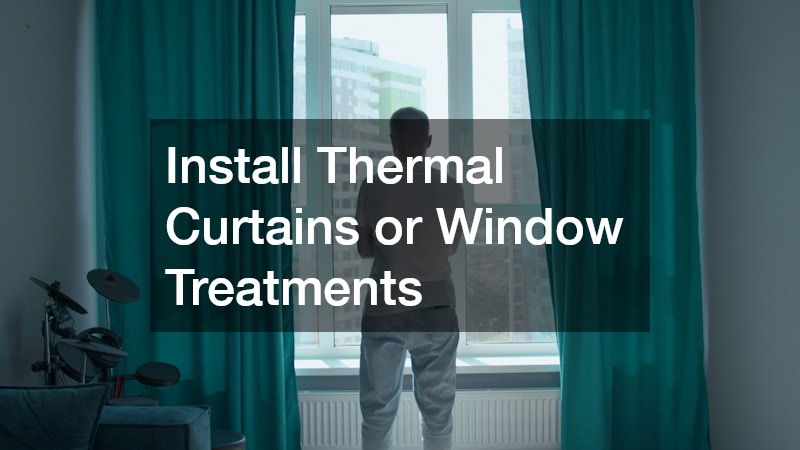10 Expert Tips for Preventing Heat Loss in Homes
Keeping your home warm and energy-efficient is essential during colder months. Heat loss can occur in many areas, from windows and doors to floors and ceilings. By taking proactive measures, homeowners can save on energy bills, improve comfort, and create a more sustainable living environment throughout the year. Here are 10 expert tips for preventing heat loss in homes this year!

1. Seal Gaps and Cracks Around Doors and Windows
One of the most common sources of heat loss in homes is gaps and cracks around doors and windows. Even small openings allow warm air to escape, forcing your heating system to work harder and increasing energy bills. To prevent this, conduct a thorough inspection of your doors and windows, looking for visible gaps or drafts. Use caulk to seal cracks around window frames and door trims, ensuring that the seal is continuous. Weatherstripping around door edges can also create an airtight barrier that minimizes heat loss. For older homes, consider adding door sweeps to prevent cold air from seeping in at the bottom. Regular maintenance is key—over time, seals may degrade or shrink, so inspect and replace them as needed. By addressing these small vulnerabilities, you not only keep your home warmer during the colder months but also improve overall energy efficiency. A well-sealed home also enhances comfort by reducing cold drafts and maintaining a consistent indoor temperature, making your living spaces more inviting while preventing heat loss in homes! This preventative step is relatively inexpensive compared to energy costs, making it one of the most cost-effective methods to reduce heat loss and maintain a cozy home environment throughout the winter.
2. Upgrade to Energy-Efficient Windows
Windows are a major factor in home heat retention. Single-pane or older windows often allow a significant amount of heat to escape. Upgrading to energy-efficient replacement windows, such as double or triple-pane models with low-emissivity (Low-E) coatings, can dramatically reduce heat loss. These windows are designed to provide better insulation, trapping warm air inside during winter while minimizing heat gain in the summer. Proper installation is crucial; poorly installed windows can create gaps that negate the benefits of the upgrade. Energy-efficient windows also reduce condensation, which can help prevent mold growth and improve indoor air quality. While the initial cost may be higher than standard windows, the long-term energy savings and increased comfort justify the investment. In addition, high-quality windows can enhance the aesthetic appeal of your home and increase its resale value. Choosing the right window materials—such as vinyl, fiberglass, or wood frames—can further improve insulation and durability. Combining energy-efficient windows with other heat-retention strategies, like curtains or blinds, maximizes the overall effectiveness of your home’s insulation. By focusing on this essential component, homeowners can significantly reduce energy consumption, lower heating bills, and maintain a warm, comfortable environment throughout the colder months.
3. Install Proper Insulation in Walls and Attics
Proper insulation is one of the most effective methods for preventing heat loss in homes. Attics and walls are key areas where heat escapes, often unnoticed, and investing in adequate insulation can result in significant energy savings. For attics, installing materials like fiberglass, cellulose, or spray foam creates a barrier that traps warm air inside, preventing it from rising and escaping through your home’s roofing. In walls, insulation helps maintain a consistent indoor temperature, keeping rooms warm during winter and cool during summer. It’s important to ensure insulation is installed evenly and without gaps, as poorly placed insulation can reduce efficiency. In older homes, consider upgrading outdated or compressed insulation that no longer provides optimal performance. Proper insulation not only reduces energy consumption but also enhances overall comfort by eliminating cold spots and drafts. Additionally, effective insulation can decrease noise transmission, improving the acoustic environment of your home. While the upfront cost may vary depending on the materials and area covered, the long-term benefits—including lower heating costs and increased home value—make insulation an essential component of heat-loss prevention. Homeowners should consult a heating contractor for accurate assessments and recommendations tailored to their specific climate and building structure to achieve maximum efficiency and comfort.

4. Insulate Your Hot Water Pipes
Insulating your hot water pipes is one of the most simple yet highly effective methods for preventing heat loss in homes. When hot water travels through uninsulated pipes, a significant amount of energy is lost as heat escapes into surrounding areas, forcing your water heater to work harder and increasing your energy bills. By wrapping pipes with foam or fiberglass insulation, you create a barrier that keeps heat contained, ensuring that water reaches faucets and appliances at the desired temperature. This not only improves energy efficiency but also reduces the wait time for hot water, enhancing comfort throughout your home. Additionally, pipe insulation by professional plumbers can help prevent condensation and protect pipes from freezing during cold months, reducing the risk of costly repairs. Overall, insulating your hot water pipes is a low-cost investment that promotes energy savings, boosts home comfort, and contributes to a more sustainable household.
5. Maintain Your Heating System Regularly
After heating and AC installation, regular maintenance of your heating system is crucial for preventing heat loss in homes and ensuring energy efficiency. Over time, furnaces, boilers, and heat pumps can lose efficiency due to clogged filters, dirty vents, or worn-out components. Replacing or cleaning air filters monthly improves airflow and reduces energy waste, while scheduling professional inspections annually helps identify and address potential problems before they escalate. Properly maintained heating systems distribute warmth more evenly, reducing the need for excessive energy consumption. Leaks or blockages in ductwork are a common cause of heat loss, and regular inspections can prevent these issues. Additionally, modernizing your heating system with programmable thermostats or upgrading to high-efficiency units can further minimize heat loss and lower utility bills. Homeowners should also be mindful of vent placement, ensuring that furniture or curtains do not block airflow. Taking a proactive approach to heating system maintenance not only saves energy and money but also extends the lifespan of your equipment. Consistent upkeep ensures your home stays warm, comfortable, and efficient throughout the winter months, providing a reliable and effective solution to combating heat loss in both older and newer homes.
6. Close Off Unused Rooms and Vents
In many homes, heat loss occurs when warm air circulates to rooms that are rarely used. By closing off these areas, you can concentrate heating in the spaces that matter most. Close vents in unused rooms, and if your system allows, adjust dampers to redirect airflow to active living spaces. This strategy reduces energy waste and allows your heating system to operate more efficiently. Doors to unused rooms can be kept shut, and draft stoppers or seals applied to prevent warm air from escaping. In multi-story homes, consider using zone heating if your system supports it, allowing you to heat only the rooms currently occupied. While closing vents is effective, homeowners should be mindful of potential issues like pressure imbalances in the ductwork, which can affect airflow and system performance. Consulting an HVAC company ensures that your system remains balanced and functions optimally. By strategically managing heat distribution, you minimize unnecessary energy use and maintain a comfortable indoor environment. Concentrating warmth in occupied areas is practical and cost-effective among solutions for preventing heat loss in homes while enhancing the overall comfort and efficiency of your home’s heating system.

7. Install Thermal Curtains or Window Treatments
Windows can be a major source of heat loss, even if they are well-sealed. Installing thermal curtains or insulating window treatments is an effective way to retain warmth indoors. These curtains are designed with special lining or multiple layers that create a barrier against cold air. During the winter months, keeping curtains closed at night helps in preventing heat loss in homes while still allowing sunlight to warm your home during the day. Layering blinds with curtains can further enhance insulation and give you additional control over indoor temperature. Thermal curtains are available in various styles and fabrics, so homeowners can maintain their interior design aesthetics while improving energy efficiency. In addition to heat retention, these curtains also reduce outside noise and can protect furniture from UV damage. For maximum effectiveness, ensure that the curtains extend past the edges of the window frame and reach the floor to prevent gaps. This simple and stylish solution allows homeowners to enjoy a warmer, cozier living environment, reduce energy bills, and complement their home décor, making it a practical and visually appealing method of minimizing heat loss.
8. Add Rugs and Carpets to Retain Floor Heat
Floors, especially in homes with tile, stone, or hardwood surfaces, can be significant contributors to heat loss. Adding rugs and carpets not only enhances comfort but also acts as an insulating layer, preventing warmth from escaping through the floor. Thick, high-pile rugs are particularly effective at trapping heat and providing a cozy surface underfoot. Layering rugs in high-traffic areas or placing them strategically near seating and sleeping areas maximizes comfort and energy efficiency. In addition to insulation, rugs help reduce noise and add aesthetic appeal to your living spaces. Homeowners can also use area rugs in combination with underfloor heating systems to further enhance warmth and energy efficiency. Choosing rugs made from natural fibers, such as wool or cotton, can provide better insulation and durability. Regularly cleaning and maintaining these rugs ensures they continue to perform well while keeping your home healthy. By paying attention to floor coverings, you address another source of heat loss, creating a warmer and more inviting environment. This simple adjustment is an affordable, practical, and stylish way to conserve heat and improve comfort throughout your home during colder months.
9. Utilize Smart Thermostats for Efficient Heating
A smart thermostat installed by a local electrician is an excellent tool for preventing heat loss in homes while maintaining a comfortable indoor environment. These devices allow homeowners to program and control their heating systems more efficiently, ensuring that energy is not wasted when no one is home. Advanced features, such as adaptive learning, occupancy sensors, and remote access via smartphones, help optimize heating schedules based on daily routines. For example, the thermostat can lower the temperature during work hours and gradually warm the home before residents return. Smart thermostats also provide insights into energy consumption, allowing homeowners to identify patterns and make adjustments to reduce waste. Integrating these devices with other smart home technology, like automated blinds or vents, further improves energy efficiency. Over time, the reduced energy usage not only lowers utility bills but also minimizes wear on heating systems. By embracing smart thermostats and reducing the energy of your power distribution units, homeowners gain precise control over indoor temperatures, preventing heat loss in homes, and create a modern, energy-efficient home that combines comfort, convenience, and sustainability.

10. Prevent Drafts From Fireplaces and Chimneys
Fireplaces are beautiful focal points in a home, but they can also be a significant source of heat loss if not properly managed. Cold air can enter through the chimney, and warm air can escape from the living room, reducing overall energy efficiency. Installing a chimney damper or ensuring the existing damper is fully closed when the fireplace is not in use helps prevent unwanted drafts. Consider using glass fireplace doors to minimize air exchange while still enjoying the aesthetic of the fireplace. Seasonal inspections and maintenance of chimneys are essential to ensure seals are intact and there are no leaks. For homes with unused fireplaces, plugging the chimney temporarily or adding an inflatable chimney balloon can prevent heat from escaping. A professional chimney cleaning company can help with this! Properly managing fireplaces ensures that warmth remains in living areas while reducing energy waste. By addressing this often-overlooked source of heat loss, homeowners can maintain a cozy environment, lower heating costs, and enjoy the benefits of their fireplace without compromising energy efficiency or comfort.
With the help of HVAC professionals, window installers, and residential roofers, preventing heat loss in homes becomes easier. These proactive tips help maintain warmth, reduce energy consumption, and enhance comfort. Implementing these measures ensures a cozy, cost-effective, and well-insulated home all year long.
